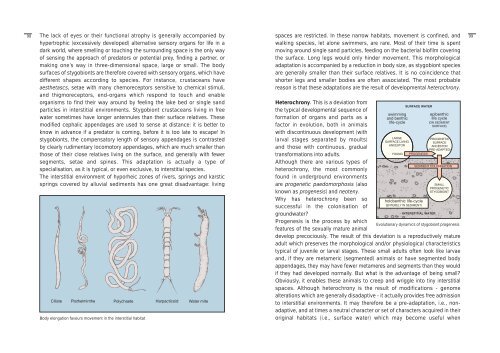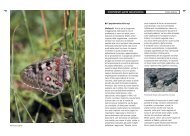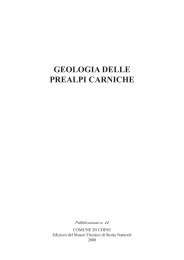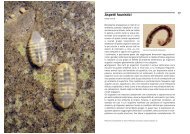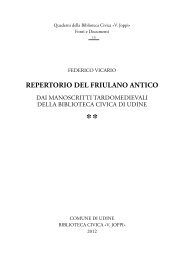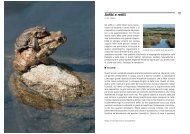Despite its inhospitable appearance and lack of any ... - Udine Cultura
Despite its inhospitable appearance and lack of any ... - Udine Cultura
Despite its inhospitable appearance and lack of any ... - Udine Cultura
Create successful ePaper yourself
Turn your PDF publications into a flip-book with our unique Google optimized e-Paper software.
98<br />
The <strong>lack</strong> <strong>of</strong> eyes or their functional atrophy is generally accompanied by<br />
hypertrophic (excessively developed) alternative sensory organs for life in a<br />
dark world, where smelling or touching the surrounding space is the only way<br />
<strong>of</strong> sensing the approach <strong>of</strong> predators or potential prey, finding a partner, or<br />
making one’s way in three-dimensional space, large or small. The body<br />
surfaces <strong>of</strong> stygobionts are therefore covered with sensory organs, which have<br />
different shapes according to species. For instance, crustaceans have<br />
aesthetascs, setae with m<strong>any</strong> chemoreceptors sensitive to chemical stimuli,<br />
<strong>and</strong> thigmoreceptors, end-organs which respond to touch <strong>and</strong> enable<br />
organisms to find their way around by feeling the lake bed or single s<strong>and</strong><br />
particles in interstitial environments. Stygobiont crustaceans living in free<br />
water sometimes have longer antennules than their surface relatives. These<br />
modified cephalic appendages are used to sense at distance: it is better to<br />
know in advance if a predator is coming, before it is too late to escape! In<br />
stygobionts, the compensatory length <strong>of</strong> sensory appendages is contrasted<br />
by clearly rudimentary locomotory appendages, which are much smaller than<br />
those <strong>of</strong> their close relatives living on the surface, <strong>and</strong> generally with fewer<br />
segments, setae <strong>and</strong> spines. This adaptation is actually a type <strong>of</strong><br />
specialisation, as it is typical, or even exclusive, to interstitial species.<br />
The interstitial environment <strong>of</strong> hyporheic zones <strong>of</strong> rivers, springs <strong>and</strong> karstic<br />
springs covered by alluvial sediments has one great disadvantage: living<br />
Body elongation favours movement in the interstitial habitat<br />
spaces are restricted. In these narrow habitats, movement is confined, <strong>and</strong><br />
walking species, let alone swimmers, are rare. Most <strong>of</strong> their time is spent<br />
moving around single s<strong>and</strong> particles, feeding on the bacterial bi<strong>of</strong>ilm covering<br />
the surface. Long legs would only hinder movement. This morphological<br />
adaptation is accompanied by a reduction in body size, as stygobiont species<br />
are generally smaller than their surface relatives. It is no coincidence that<br />
shorter legs <strong>and</strong> smaller bodies are <strong>of</strong>ten associated. The most probable<br />
reason is that these adaptations are the result <strong>of</strong> developmental heterochrony.<br />
Heterochrony. This is a deviation from<br />
the typical developmental sequence <strong>of</strong><br />
formation <strong>of</strong> organs <strong>and</strong> parts as a<br />
factor in evolution, both in animals<br />
with discontinuous development (with<br />
larval stages separated by moults)<br />
<strong>and</strong> those with continuous, gradual<br />
transformations into adults.<br />
Although there are various types <strong>of</strong><br />
heterochrony, the most commonly<br />
found in underground environments<br />
are progenetic paedomorphosis (also<br />
known as progenesis) <strong>and</strong> neoteny.<br />
Why has heterochrony been so<br />
successful in the colonisation <strong>of</strong><br />
groundwater?<br />
Progenesis is the process by which<br />
Evolutionary dynamics <strong>of</strong> stygobiont progenesis<br />
features <strong>of</strong> the sexually mature animal<br />
develop precociously. The result <strong>of</strong> this deviation is a reproductively mature<br />
adult which preserves the morphological <strong>and</strong>/or physiological characteristics<br />
typical <strong>of</strong> juvenile or larval stages. These small adults <strong>of</strong>ten look like larvae<br />
<strong>and</strong>, if they are metameric (segmented) animals or have segmented body<br />
appendages, they may have fewer metameres <strong>and</strong> segments than they would<br />
if they had developed normally. But what is the advantage <strong>of</strong> being small?<br />
Obviously, it enables these animals to creep <strong>and</strong> wriggle into tiny interstitial<br />
spaces. Although heterochrony is the result <strong>of</strong> modifications - genome<br />
alterations which are generally disadaptive - it actually provides free admission<br />
to interstitial environments. It may therefore be a pre-adaptation, i.e., nonadaptive,<br />
<strong>and</strong> at times a neutral character or set <strong>of</strong> characters acquired in their<br />
original habitats (i.e., surface water) which may become useful when<br />
99


